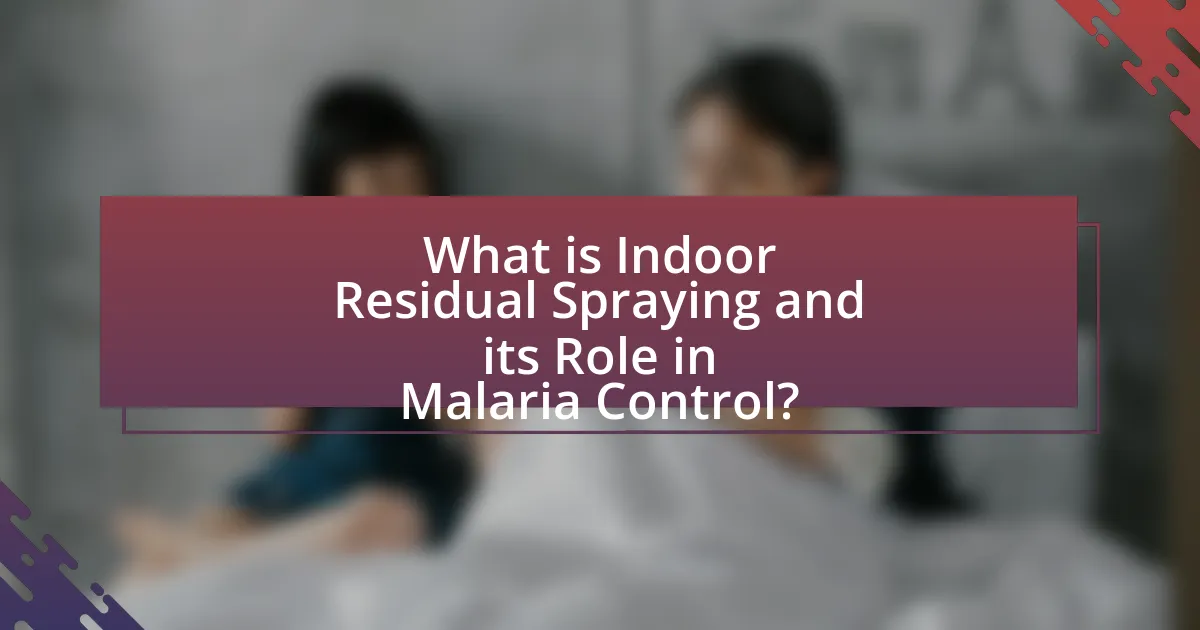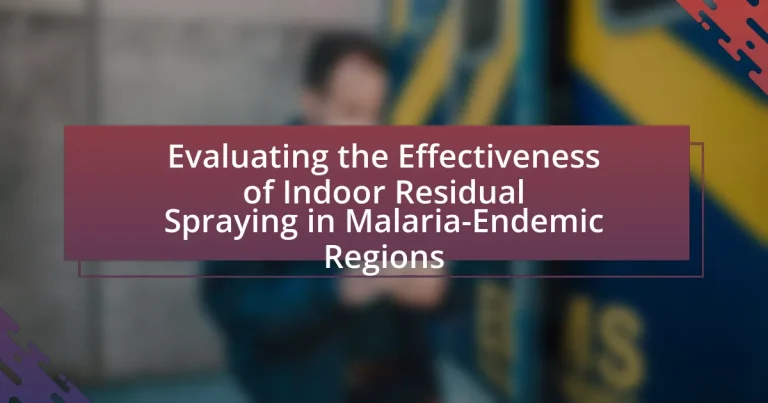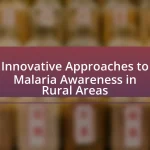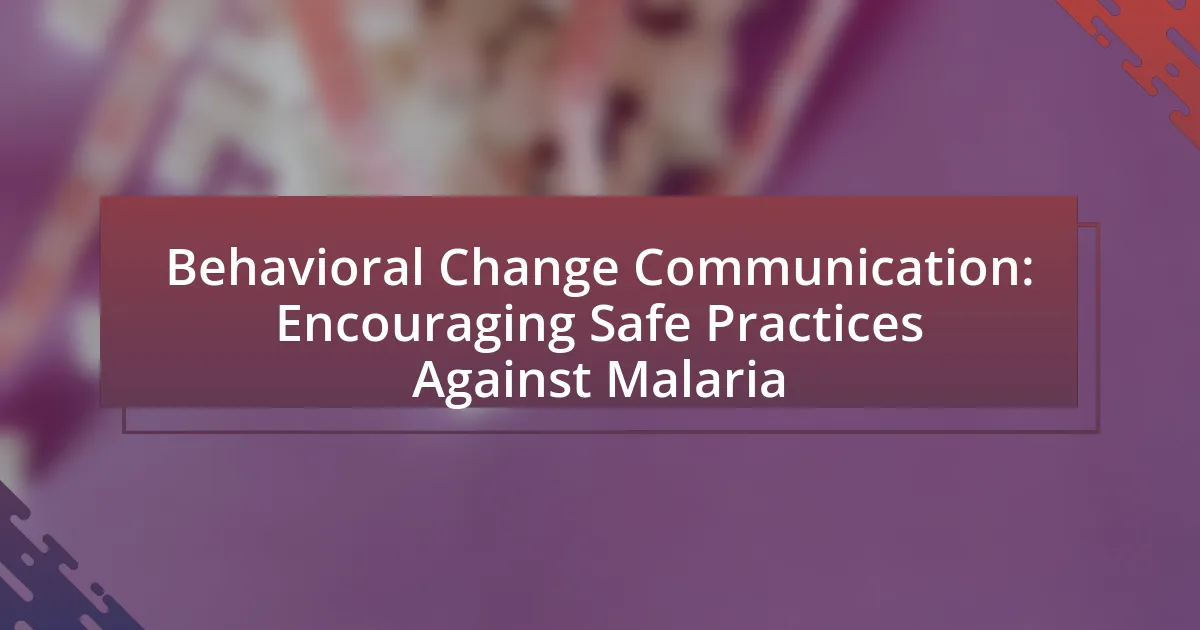Indoor Residual Spraying (IRS) is a critical malaria control method that involves applying insecticides to the interior surfaces of homes to eliminate malaria-carrying mosquitoes. This article evaluates the effectiveness of IRS in malaria-endemic regions, highlighting its role in reducing malaria transmission rates by targeting adult mosquitoes. Key factors influencing IRS effectiveness, such as the type of insecticides used, environmental conditions, and community engagement, are discussed. Additionally, the article examines the challenges faced in implementing IRS, the metrics for evaluating its impact, and practical recommendations for enhancing its efficacy in controlling malaria.

What is Indoor Residual Spraying and its Role in Malaria Control?
Indoor Residual Spraying (IRS) is a malaria control method that involves applying insecticides to the interior surfaces of homes to kill malaria-carrying mosquitoes. This technique significantly reduces malaria transmission by targeting adult mosquitoes that rest on walls and ceilings after feeding. Studies have shown that IRS can lead to a substantial decrease in malaria cases; for instance, a systematic review indicated that IRS reduced malaria incidence by 50% in some regions. By effectively controlling mosquito populations, IRS plays a crucial role in malaria prevention strategies, particularly in endemic areas where the disease is prevalent.
How does Indoor Residual Spraying work in malaria-endemic regions?
Indoor Residual Spraying (IRS) works in malaria-endemic regions by applying insecticides to the interior walls of homes, targeting adult mosquitoes that rest indoors after feeding. This method reduces malaria transmission by killing mosquitoes upon contact with treated surfaces, thereby decreasing their population and the likelihood of malaria spread. Studies have shown that IRS can lead to a significant reduction in malaria cases; for instance, a systematic review indicated that IRS can reduce malaria incidence by up to 50% in treated areas.
What insecticides are commonly used in Indoor Residual Spraying?
Common insecticides used in Indoor Residual Spraying (IRS) include pyrethroids, organophosphates, and carbamates. Pyrethroids, such as deltamethrin and lambda-cyhalothrin, are widely favored due to their effectiveness against malaria vectors and low toxicity to humans. Organophosphates like malathion and chlorpyrifos are also utilized, providing a different mode of action that can help manage insecticide resistance. Carbamates, such as bendiocarb, are occasionally employed as well. The World Health Organization recommends these insecticides for IRS to control malaria transmission effectively, highlighting their role in public health interventions.
How is Indoor Residual Spraying applied in households?
Indoor Residual Spraying (IRS) is applied in households by directly spraying insecticide on the interior surfaces of homes, including walls, ceilings, and other surfaces where mosquitoes may rest. This method ensures that the insecticide remains effective for several months, targeting malaria-carrying mosquitoes and reducing their populations. The application typically involves trained personnel using specialized equipment to ensure even coverage and adherence to safety protocols, which is crucial for maximizing efficacy and minimizing health risks to residents. Studies have shown that IRS can significantly decrease malaria transmission rates in endemic regions, highlighting its role as a key intervention in malaria control strategies.
What are the primary goals of Indoor Residual Spraying?
The primary goals of Indoor Residual Spraying (IRS) are to reduce malaria transmission by killing adult mosquitoes that rest on indoor surfaces and to provide a protective barrier against future mosquito infestations. IRS targets the vector population, specifically Anopheles mosquitoes, which are responsible for malaria transmission. Studies have shown that IRS can lead to a significant decrease in malaria cases; for instance, a systematic review indicated that IRS reduced malaria incidence by up to 50% in treated areas. This method is a key component of integrated vector management strategies aimed at controlling malaria in endemic regions.
How does Indoor Residual Spraying contribute to reducing malaria transmission?
Indoor Residual Spraying (IRS) significantly reduces malaria transmission by applying insecticides to the interior surfaces of homes, which kills malaria-carrying mosquitoes upon contact. This method effectively decreases the mosquito population in residential areas, thereby lowering the likelihood of malaria transmission to humans. Studies have shown that IRS can reduce malaria incidence by up to 50% in treated areas, as evidenced by research published in the journal “The Lancet,” which demonstrated a marked decline in malaria cases following IRS implementation in various endemic regions.
What are the expected outcomes of implementing Indoor Residual Spraying?
The expected outcomes of implementing Indoor Residual Spraying (IRS) include a significant reduction in malaria transmission rates and decreased mosquito populations. IRS effectively targets adult mosquitoes that rest on indoor surfaces, leading to a decline in their lifespan and reproductive capacity. Studies have shown that IRS can reduce malaria incidence by up to 50% in treated areas, as evidenced by research conducted in various malaria-endemic regions, including a systematic review published in the Lancet Infectious Diseases, which highlighted the effectiveness of IRS in lowering malaria cases. Additionally, IRS contributes to improved public health outcomes by reducing the burden of malaria-related morbidity and mortality in affected communities.

What factors influence the effectiveness of Indoor Residual Spraying?
The effectiveness of Indoor Residual Spraying (IRS) is influenced by several key factors, including the type of insecticide used, the timing and frequency of application, the coverage area, and the local environmental conditions. The choice of insecticide is critical, as different chemicals have varying residual effects and efficacy against specific mosquito species. For instance, pyrethroids are commonly used due to their effectiveness against malaria vectors, but resistance can diminish their impact.
Timing and frequency of spraying also play a significant role; for optimal results, IRS should be applied during peak transmission seasons and at intervals that maintain effective insecticide levels. Coverage area is essential, as incomplete spraying can lead to refuges for mosquitoes, undermining the overall effectiveness. Environmental conditions, such as humidity and temperature, can affect the degradation of the insecticide and the behavior of the target mosquito populations, further influencing IRS outcomes.
Research indicates that these factors collectively determine the success of IRS in reducing malaria transmission, highlighting the need for tailored strategies in different malaria-endemic regions.
How do environmental conditions affect Indoor Residual Spraying outcomes?
Environmental conditions significantly influence the outcomes of Indoor Residual Spraying (IRS) by affecting the persistence and efficacy of insecticides. Factors such as temperature, humidity, and surface type can alter the degradation rate of the insecticide, impacting its effectiveness against malaria vectors. For instance, high temperatures can accelerate the breakdown of certain insecticides, reducing their residual activity, while high humidity can enhance the absorption of the insecticide into surfaces, potentially increasing its effectiveness. Studies have shown that in regions with high humidity and moderate temperatures, IRS can remain effective for longer periods, thereby improving malaria control efforts.
What role does humidity and temperature play in insecticide efficacy?
Humidity and temperature significantly influence insecticide efficacy by affecting the chemical stability and biological activity of the insecticides. High humidity can enhance the absorption of insecticides by pests, while extreme temperatures may degrade the active ingredients, reducing their effectiveness. For instance, studies have shown that elevated temperatures can lead to faster evaporation rates of certain insecticides, diminishing their residual activity on surfaces. Conversely, optimal humidity levels can prolong the effectiveness of insecticides by maintaining their formulation integrity.
How does the type of housing impact the effectiveness of Indoor Residual Spraying?
The type of housing significantly impacts the effectiveness of Indoor Residual Spraying (IRS) by influencing the surface area available for insecticide application and the duration of insecticide efficacy. Structures with mud or thatch walls tend to absorb insecticides more quickly, reducing their residual effect, while houses made of concrete or brick provide a more stable surface that retains insecticides longer, enhancing their effectiveness against malaria vectors. Studies have shown that IRS in concrete houses can lead to a 50% reduction in malaria transmission compared to traditional mud houses, highlighting the importance of housing type in IRS strategies.
What are the challenges faced in implementing Indoor Residual Spraying?
The challenges faced in implementing Indoor Residual Spraying (IRS) include logistical issues, community acceptance, and insecticide resistance. Logistical challenges arise from the need for proper training of personnel, timely supply of insecticides, and effective distribution methods. Community acceptance is critical, as residents may have concerns about health risks or the efficacy of the spraying, which can hinder participation. Insecticide resistance is a significant challenge, as mosquitoes may develop resistance to commonly used insecticides, reducing the effectiveness of IRS. According to the World Health Organization, these factors can significantly impact the overall success of IRS programs in malaria-endemic regions.
How do community acceptance and participation influence the success of Indoor Residual Spraying?
Community acceptance and participation are critical for the success of Indoor Residual Spraying (IRS) as they directly impact the implementation and sustainability of the intervention. When communities are engaged and supportive, they are more likely to allow access to their homes for spraying, adhere to safety guidelines, and report any adverse effects, which enhances the overall effectiveness of IRS. Studies have shown that high levels of community acceptance can lead to increased coverage rates, which are essential for achieving the desired reduction in malaria transmission. For instance, a study in Kenya indicated that community involvement in the planning and execution of IRS led to a 30% increase in coverage compared to areas with low community engagement. This demonstrates that fostering trust and collaboration between health authorities and local populations is vital for the successful deployment of IRS in malaria-endemic regions.
What logistical issues can hinder the effective deployment of Indoor Residual Spraying?
Logistical issues that can hinder the effective deployment of Indoor Residual Spraying (IRS) include inadequate supply chain management, insufficient training of personnel, and poor community engagement. Inadequate supply chain management can lead to delays in the delivery of insecticides and equipment, which are critical for timely spraying operations. Insufficient training of personnel affects the quality of application and safety protocols, potentially reducing the effectiveness of the spraying. Poor community engagement can result in resistance from local populations, undermining the acceptance and success of IRS initiatives. These factors collectively impede the overall effectiveness of IRS in controlling malaria transmission.

How is the effectiveness of Indoor Residual Spraying evaluated?
The effectiveness of Indoor Residual Spraying (IRS) is evaluated through a combination of entomological and epidemiological assessments. Entomological evaluations involve measuring the mortality rates of target mosquito populations after exposure to the insecticide, as well as monitoring the density and behavior of these populations over time. Epidemiological assessments focus on tracking malaria incidence rates in the population before and after IRS implementation, often using statistical methods to determine the impact on disease transmission. Studies have shown that IRS can reduce malaria transmission by up to 90% in some regions, demonstrating its effectiveness when properly implemented.
What metrics are used to assess the impact of Indoor Residual Spraying on malaria incidence?
The metrics used to assess the impact of Indoor Residual Spraying (IRS) on malaria incidence include the reduction in malaria transmission rates, the incidence of malaria cases, and the prevalence of malaria parasites in the population. Specifically, studies often measure the number of confirmed malaria cases before and after IRS implementation, as well as the entomological inoculation rate, which quantifies the number of infectious bites received by humans. Additionally, vector density and species composition are monitored to evaluate changes in mosquito populations. For instance, a systematic review published in the journal “Malaria Journal” found that IRS can lead to a significant decrease in malaria incidence, with reductions of up to 50% in some regions.
How do researchers measure changes in malaria transmission rates?
Researchers measure changes in malaria transmission rates primarily through entomological and epidemiological methods. Entomological methods include monitoring mosquito populations, assessing their infection rates with malaria parasites, and evaluating the effectiveness of vector control measures such as Indoor Residual Spraying (IRS). Epidemiological methods involve tracking malaria case incidence, prevalence, and mortality rates in the population over time. For instance, studies have shown that a reduction in malaria cases correlates with increased IRS coverage, indicating its effectiveness in lowering transmission rates.
What role do entomological studies play in evaluating Indoor Residual Spraying effectiveness?
Entomological studies are crucial for evaluating the effectiveness of Indoor Residual Spraying (IRS) as they provide data on insecticide resistance, mosquito population dynamics, and the impact of spraying on malaria transmission. These studies assess the mortality rates of target mosquito species after IRS application, which directly indicates the efficacy of the insecticide used. For instance, research has shown that monitoring the susceptibility of Anopheles mosquitoes to insecticides can reveal resistance patterns that may compromise IRS effectiveness, as documented in studies like “Insecticide Resistance in Malaria Vectors: A Global Perspective” published in the journal PLOS Medicine. By analyzing these factors, entomological studies help refine IRS strategies, ensuring they remain effective in controlling malaria transmission in endemic regions.
What are the best practices for monitoring and evaluating Indoor Residual Spraying programs?
The best practices for monitoring and evaluating Indoor Residual Spraying (IRS) programs include establishing clear objectives, conducting pre- and post-spray assessments, and utilizing entomological and epidemiological indicators. Clear objectives guide the evaluation process, ensuring that specific outcomes are measured. Pre- and post-spray assessments help determine the baseline conditions and the impact of the spraying, while entomological indicators, such as mosquito density and species composition, provide insights into the effectiveness of the intervention. Epidemiological indicators, including malaria incidence rates, further assess the program’s impact on disease transmission. These practices are supported by studies indicating that systematic monitoring leads to improved program outcomes and better resource allocation in malaria-endemic regions.
How can data collection be optimized for better evaluation outcomes?
Data collection can be optimized for better evaluation outcomes by implementing standardized protocols and utilizing technology for real-time data capture. Standardized protocols ensure consistency in data collection methods, which enhances the reliability of the data. For instance, using mobile data collection tools can streamline the process, reduce human error, and facilitate immediate data analysis. A study by the World Health Organization highlights that employing electronic data collection methods can improve data accuracy and timeliness, leading to more effective evaluations in public health interventions, such as indoor residual spraying for malaria control.
What strategies can enhance community engagement in monitoring efforts?
Strategies that can enhance community engagement in monitoring efforts include fostering partnerships with local organizations, utilizing community leaders for outreach, and implementing participatory monitoring approaches. Partnerships with local organizations leverage existing trust and networks, facilitating better communication and involvement. Engaging community leaders as advocates can motivate residents to participate actively, as they often hold influence and credibility within the community. Participatory monitoring approaches, where community members are directly involved in data collection and analysis, empower individuals and increase ownership of the monitoring process. Evidence from studies in public health initiatives shows that these strategies significantly improve community participation and data accuracy, leading to more effective monitoring outcomes.
What practical recommendations can improve the effectiveness of Indoor Residual Spraying?
To improve the effectiveness of Indoor Residual Spraying (IRS), it is essential to ensure proper timing and frequency of applications. Research indicates that spraying should coincide with peak mosquito activity and transmission seasons to maximize impact. Additionally, using high-quality insecticides that are effective against local mosquito populations is crucial, as resistance can diminish efficacy.
Training personnel in correct spraying techniques enhances coverage and reduces missed areas, which is vital for effective vector control. Furthermore, integrating IRS with other malaria control strategies, such as insecticide-treated nets and environmental management, has been shown to provide synergistic effects, leading to better overall outcomes in malaria-endemic regions.
Evidence from studies, such as those published in the “American Journal of Tropical Medicine and Hygiene,” supports these recommendations by demonstrating that coordinated efforts and strategic planning significantly enhance the impact of IRS on malaria transmission rates.





